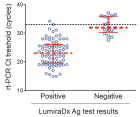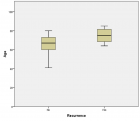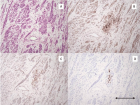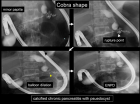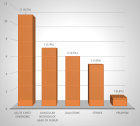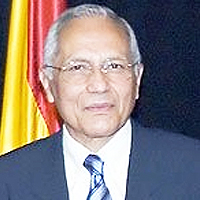Abstract
Research Article
Dairy cattle producers’ perception on Oestrus Synchronization and mass artificial insemination services in Waliso and Ilu Districts of South West Shoa Zone of Oromia, Ethiopia
Abera Fekata*, Ulfina Galmessa, Lemma Fita, Chala Merera and Amanuel Bekuma
Published: 05 March, 2020 | Volume 4 - Issue 1 | Pages: 010-013
The study was conducted in Ilu and Waliso districs of South West Shoa Zone to investigate the perception of dairy cattle producers on oestrus synchronization and mass artificial insemination services. A total of 122 respondents (38 from Ilu and 84 from Waliso districts) owning at least one lactating cow and participated in synchronization program were randomly selected and interviewed individually by using semi- structured questionnaire. Both primary and secondary data were used to generate reliable information on the intended topic. All collected data were analyzed using SPSS statistical package version 20 and the output was presented by descriptive statistics such as percentage and mean values in inform of graphs. Most of the respondents (67.15%) indicated that their satisfaction level towards synchronization and mass artificial insemination was low. Only few of them reported being satisfied as (medium-13.45%, good - 12.35% and very good - 7.05%). This might be because of shortage of feed, silent heat, poor performance of the inseminator and low awareness of farmers on the technology. From the study it was also noted that the overall percentage (26.22%) of calving rate to oestrus synchronization and mass artificial insemination was low. This might be due to heat detection problem (36%); A.I technician efficiency (29.25%), absence of A.I technician (23.9%) and distance of A.I center (10.25%). Therefore, the skill and knowledge based training should be given for both the farmers and implementers to enhance perception and adoption of the technology.
Read Full Article HTML DOI: 10.29328/journal.ivs.1001020 Cite this Article Read Full Article PDF
Keywords:
Perception; Synchronization; Mass Insemination; Ilu and Waliso; Ethiopia
References
- Food and Agriculture Organization (FAO). The State of World Fisheries and Aquaculture. FAO Fisheries and Aquaculture Department, Food and Agriculture Organization of the United Nations Rome. 2014.
- Central Statistical Agency (CSA). Federal Democratic Republic of Ethiopia, Agricultural Sample Survey, Volume II, Report On Livestock And Livestock Characteristics (Private Peasant Holdings). Statistical bulletin, 587, April 2018, Addis Ababa, Ethiopia. 2018.
- Tadesse B. Calf Sex Ratios in Artificially Inseminated and Natural Mated Female Crossbred Dairy Herd. In: Proceedings of the 13 annual Conference of the Ethiopian Society of Animal Production. Addis Ababa, Ethiopia. 2008; 227.
- Tegegne A, Estifanos A, Tera A, Hoekstra D.. Technological Options and Approaches to Improve Smallholder Access to Desirable Animal Genetic Material for Dairy Development: IPMS (Improving Productivity and Market Success) Experience with Hormonal Oestrus Synchronization and Mass Insemination in Ethiopia. “Resilience of agricultural systems against crises” Göttingen. 2012.
- Ahmed S, Mohammed A, Nuraddis I, Misganu A. Perception of Dairy Cattle Owners on Oestrus Synchronization and Mass Artificial Insemination Services in Jimma Zone, South Western Ethiopia. Greener J Agri Sci. 2017; 7: 137-144.
- Sinishaw W. Study on Semen Quality and Field Efficiency of AI Bulls Kept at The National Artificial Insemination Center. MSc thesis, Addis Ababa University, Faculty of veterinary Medicine, Debre Zeit. Ethiopia. 2005; 13-17.
- Gebremedhin D. Assessment of Problems / Constraints Associated with Artificial insemination service in Ethiopia. M.Sc. Thesis. Addis Ababa University Faculty of veterinary medicine, Debre Zeit, Ethiopia. 2008.
- Gizaw S, Tesfaye Y, Mekuriaw Z, Tadesse M, Hoekstra D, et al. Oestrus Synchronization for Accelerated Delivery of Improved Dairy Genetics In Ethiopia: Results From Action Research And Development Interventions. LIVES Working Paper 12. Nairobi, Kenya: International Livestock Research Institute (ILRI). 2016.
- Legesse D. Assessment of breeding practices and evaluation of mass estrus synchronization of dairy cattle in sidama zone, southern Ethiopia. MSc. thesis, department of animal and range science, Hawassa University, Ethiopia. Journal of Natural Sciences Research, 2015; 6.
- Tegegne A, Warnick AC, Mukasa Mugerwa E, Ketema H. Fertility of Bos Indicus and Bos Indicus X Bos Taurus Crossbred Cattle after Oestrus Synchronization. Theriogenology. 1989; 31: 361-370. PubMed: https://www.ncbi.nlm.nih.gov/pubmed/16726556
- Ilu District Livestock and Fishery Resources Development Office (IDLFRDO), 2017.
- Waliso District Livestock and Fishery Resources Development Office (WDLFRDO) 2017.
- Yamane, Taro. Statistics: An Introductory Analysis, 2nd Edition, New York: Harper and Row. 1967.
- Alemneh T, Mogess W, Marew G, Adera Z.. Study on the Conception Rate of Dairy Cows Artificially Inseminated During Natural Heat and By Synchronization in Fogera Woreda, North-West of Ethiopia. Faculty of Veterinary Medicine, University of Gondar, P.O. Box: 196.Ethiopia. African Journal of Basic & Applied Sciences. 2015; 7: 291-297.
- Bainesagn W. Assesment of breeding practices and evaluation of estrus synchronization and mass insemination technique in dairy cattle in West Shoa zone. Msc thesis, Haramaya University, Ethiopia. 2015.
- Husni I, dan Pudji Srianto A. Upaya Meningkatkan Angka Kebuntingan Melalui Inseminasi Ganda dalam Program Penyerentak Birahi pada Sapi Perah. Lembaga Penelitian Universitas Airlangga. 2000.
- Debir Legesse 2015. Assessment of breeding practices and evaluation of mass estrus synchronization of dairy cattle in sidama zone, southern Ethiopia. MSc. thesis, department of animal and range science, Hawassa University, Ethiopia. J Na Sci Res. 2016; 6.
Figures:

Figure 1

Figure 2

Figure 3
Similar Articles
-
Dairy cattle producers’ perception on Oestrus Synchronization and mass artificial insemination services in Waliso and Ilu Districts of South West Shoa Zone of Oromia, EthiopiaAbera Fekata*,Ulfina Galmessa,Lemma Fita,Chala Merera,Amanuel Bekuma. Dairy cattle producers’ perception on Oestrus Synchronization and mass artificial insemination services in Waliso and Ilu Districts of South West Shoa Zone of Oromia, Ethiopia. . 2020 doi: 10.29328/journal.ivs.1001020; 4: 010-013
-
Review on epidemiology of bovine hemoparasites in EthiopiaGudina Mekonnen Ayana,Wakgari Oljira Fayisa*. Review on epidemiology of bovine hemoparasites in Ethiopia. . 2022 doi: 10.29328/journal.ivs.1001036; 6: 013-016
Recently Viewed
-
Navigating Weight Management with Stevia: Insights into Glycemic ControlShashikanth Kharat*, Sanjana Mali*. Navigating Weight Management with Stevia: Insights into Glycemic Control. New Insights Obes Gene Beyond. 2024: doi: 10.29328/journal.niogb.1001021; 8: 006-008
-
Screening for Depressive Symptoms in Clinical and Nonclinical Youth: The Psychometric Properties of the Dutch Children’s Depression Inventory-2 (CDI-2)Denise Bodden*. Screening for Depressive Symptoms in Clinical and Nonclinical Youth: The Psychometric Properties of the Dutch Children’s Depression Inventory-2 (CDI-2). Insights Depress Anxiety. 2025: doi: 10.29328/journal.ida.1001047; 9: 028-039
-
The Bacteriological Profile of Nosocomial Infections at the Army Central Hospital of BrazzavilleMedard Amona*,Yolande Voumbo Matoumona Mavoungou,Hama Nemet Ondzotto,Benjamin Kokolo,Armel Itoua,Gilius Axel Aloumba,Pascal Ibata. The Bacteriological Profile of Nosocomial Infections at the Army Central Hospital of Brazzaville. Int J Clin Microbiol Biochem Technol. 2025: doi: 10.29328/journal.ijcmbt.1001032; 8: 009-022
-
Indian spices and Caffeine treatment for Obesity and Cardiovascular diseaseIan James Martins*. Indian spices and Caffeine treatment for Obesity and Cardiovascular disease. Ann Clin Endocrinol Metabol. 2018: doi: 10.29328/journal.acem.1001005; 2: 010-014
-
Intravenous Leiomyomatosis of the Uterus with Intracardiac ExtensionTomas Reyes-del Castillo*,Minerva I Hernandez-Rejon,Jose L Ruiz-Pier,Mario Peñaloza-Guadarrama,Carlos E Merinos-Avila,Cristina Juarez-Cabrera,Pedro A del Valle-Maldonado,Sofia Ley-Tapia,Valentín Gonzalez-Flores. Intravenous Leiomyomatosis of the Uterus with Intracardiac Extension. Arch Vas Med. 2025: doi: 10.29328/journal.avm.1001021; 9: 003-007
Most Viewed
-
Impact of Latex Sensitization on Asthma and Rhinitis Progression: A Study at Abidjan-Cocody University Hospital - Côte d’Ivoire (Progression of Asthma and Rhinitis related to Latex Sensitization)Dasse Sery Romuald*, KL Siransy, N Koffi, RO Yeboah, EK Nguessan, HA Adou, VP Goran-Kouacou, AU Assi, JY Seri, S Moussa, D Oura, CL Memel, H Koya, E Atoukoula. Impact of Latex Sensitization on Asthma and Rhinitis Progression: A Study at Abidjan-Cocody University Hospital - Côte d’Ivoire (Progression of Asthma and Rhinitis related to Latex Sensitization). Arch Asthma Allergy Immunol. 2024 doi: 10.29328/journal.aaai.1001035; 8: 007-012
-
Causal Link between Human Blood Metabolites and Asthma: An Investigation Using Mendelian RandomizationYong-Qing Zhu, Xiao-Yan Meng, Jing-Hua Yang*. Causal Link between Human Blood Metabolites and Asthma: An Investigation Using Mendelian Randomization. Arch Asthma Allergy Immunol. 2023 doi: 10.29328/journal.aaai.1001032; 7: 012-022
-
An algorithm to safely manage oral food challenge in an office-based setting for children with multiple food allergiesNathalie Cottel,Aïcha Dieme,Véronique Orcel,Yannick Chantran,Mélisande Bourgoin-Heck,Jocelyne Just. An algorithm to safely manage oral food challenge in an office-based setting for children with multiple food allergies. Arch Asthma Allergy Immunol. 2021 doi: 10.29328/journal.aaai.1001027; 5: 030-037
-
Snow white: an allergic girl?Oreste Vittore Brenna*. Snow white: an allergic girl?. Arch Asthma Allergy Immunol. 2022 doi: 10.29328/journal.aaai.1001029; 6: 001-002
-
Cytokine intoxication as a model of cell apoptosis and predict of schizophrenia - like affective disordersElena Viktorovna Drozdova*. Cytokine intoxication as a model of cell apoptosis and predict of schizophrenia - like affective disorders. Arch Asthma Allergy Immunol. 2021 doi: 10.29328/journal.aaai.1001028; 5: 038-040

If you are already a member of our network and need to keep track of any developments regarding a question you have already submitted, click "take me to my Query."






